Characterization of Recovery in Asphalt Binders
Abstract
1. Introduction
2. Measurement of Internal Stress in Asphalt Binders
2.1. Measurement Principle of the CSR Test
- σk < σi so σe < 0: the residue strain decreases with time, as indicated by .
- σk = σi so σe = 0: the residue strain remains constant, as indicated by .
- σk > σi so σe > 0: the residue strain increases with time, as indicated by .
2.2. Design of CSR Test for Asphalt Binders
3. Materials and Tests
4. Verification of CSR Test in Asphalt Binders
4.1. Verification of Loading Conditions
4.2. Effect of Disturbance by Step-Loads
4.3. Accuracy of Measured Internal Stress
5. Characterization of Recovery Properties for Asphalt Binders
- (1)
- The proposal of the kinetics-based model to evaluate and predict the recovery properties for asphalt binders; and
- (2)
- The analysis of the model results for both undamaged and damaged asphalt binders.
5.1. Development of the Kinetics-Based Recovery Model
5.2. Analysis of the Modeling Results
6. Conclusions and Future Work
- The CSR test to measure the internal stress in asphalt binders is feasible and accurate at 15 °C, 25 °C, and 35 °C. It is applicable to both the unaged base binder and SBS modified binder.
- For the destructive CSR test, the creep compliance cannot be calculated beyond the loading period, so it is of great significance to use the destructive CSR test to measure the internal stress of damaged asphalt binders.
- The kinetics-based recovery model is developed for both an unaged base binder and SBS modified binder at 15 °C, 25 °C, and 35 °C based on the recovery modulus. The change of recovery modulus with the recovery time can be predicted accurately based on this model.
- The recovery modulus decreases when the temperatures increase from 15 °C to 35 °C. The constant-rate recovery activation energy indicates major differences between nondestructive and destructive loading conditions in unaged asphalt binders, while the fast-rate recovery activation energy stays almost constant regardless of the loading conditions.
- The activation energy for healing is calculated by the constant-rate recovery activation energy of both undamaged and damaged unaged base binder and SBS modified binders. The results indicate that SBS modified unaged asphalt binder has better healing abilities than the unaged base binder.
Author Contributions
Funding
Conflicts of Interest
References
- Zhang, Y.; Luo, X.; Onifade, I.; Huang, X.; Lytton, R.L.; Birgisson, B. Mechanical evaluation of aggregate gradation to characterize load carrying capacity and rutting resistance of asphalt mixtures. Constr. Build. Mater. 2019, 205, 499–510. [Google Scholar] [CrossRef]
- Zhang, W.; Shen, S.; Wu, S.; Chen, X.; Xue, J.; Mohammad, L.N. Effects of In-Place Volumetric Properties on Field Rutting and Cracking Performance of Asphalt Pavement. J. Mater. Civil. Eng. 2019, 31. [Google Scholar] [CrossRef]
- Du, Y.; Chen, J.; Han, Z.; Liu, W. A review on solutions for improving rutting resistance of asphalt pavement and test methods. Constr. Build. Mater. 2018, 168, 893–905. [Google Scholar] [CrossRef]
- Hussan, S.; Kamal, M.A.; Hafeez, I.; Farooq, D.; Ahmad, N.; Khanzada, S. Statistical evaluation of factors affecting the laboratory rutting susceptibility of asphalt mixtures. Int. J. Pavement Eng. 2019, 20, 402–416. [Google Scholar] [CrossRef]
- Tan, Y.; Shan, L.; Kim, Y.R.; Underwood, B.S. Healing characteristics of asphalt binder. Constr. Build. Mater. 2012, 27, 570–577. [Google Scholar] [CrossRef]
- Isailović, I.; Wistuba, M.P.; Cannone Falchetto, A. Investigation on mixture recovery properties in fatigue tests. Road Mater. Pavement Des. 2018, 19, 1230–1240. [Google Scholar] [CrossRef]
- Yildirim, Y. Polymer modified asphalt binders. Constr. Build. Mater. 2007, 21, 66–72. [Google Scholar] [CrossRef]
- Arega, Z.; Sakib, N.; Bhasin, A.; Peterson, J. An Investigation into the Continuous High-Temperature Grade and Elastic Recovery of Asphalt Binders Measured Using the Creep-Recovery Test. J. Test. Eval. 2017, 45, 1671–1679. [Google Scholar] [CrossRef]
- Saboo, N.; Kumar, P. A study on creep and recovery behavior of asphalt binders. Constr. Build. Mater. 2015, 96, 632–640. [Google Scholar] [CrossRef]
- D’Angelo, J.; Dongre, R. Practical use of the MSCR test: Characterization of SBS dispersion and other additives in PMA binders. J. Transport. Res. Rec. 2009, 2126, 73–82. [Google Scholar] [CrossRef]
- Ali, A.W.; Kim, H.H.; Mithil, M.; Moon-Sup, L.; Soon-Jac, L. Multiple Stress Creep Recovery (MSCR) characterization of polymer modified asphalt binder containing wax additives. Int. J. Pavement Res. Technol. 2018, 11, 774–788. [Google Scholar] [CrossRef]
- AASHTO. TP 70: Standard Method of Test for Multiple Stress Creep Recovery (MSCR) Test of Asphalt Binder Using a Dynamic Shear Rheometer (DSR); AASHTO: Washington, DC, USA, 2012. [Google Scholar]
- D’Angelo, J.A.; Dongre, R.N. Creep and recovery. Public Roads 2007, 70, 24–30. [Google Scholar]
- Moreno-Navarro, F.; Tauste, R.; Sol-Sánchez, M.; Rubio-Gámez, M.C. New approach for characterising the performance of asphalt binders through the multiple stress creep and recovery test. Road Mater. Pavement Des. 2019, 20 (Suppl. 1), S500–S520. [Google Scholar] [CrossRef]
- Federal Highway Administration. The multiple stress creep recovery (MSCR) procedure. Techbrief 2011, 11, 038. [Google Scholar]
- Abermann, R. Measurements of the intrinsic stress in thin metal films. Vacuum 1990, 41, 1279–1282. [Google Scholar] [CrossRef]
- Lee, C.C.; Tien, C.L.; Sheu, W.S.; Jaing, C.C. An apparatus for the measurement of internal stress and thermal expansion coefficient of metal oxide films. Rev. Sci. Instrum. 2001, 72, 2128–2133. [Google Scholar] [CrossRef]
- Gall, K.; Dunn, M.L.; Liu, Y.; Stefanic, G.; Balzar, D. Internal stress storage in shape memory polymer nanocomposites. Appl. Phys. Lett. 2004, 85, 290–292. [Google Scholar] [CrossRef]
- Wiesauer, K.; Dufau, A.S.; Götzinger, E.; Pircher, M.; Hitzenberger, C.K.; Stifter, D. Non-destructive quantification of internal stress in polymer materials by polarisation sensitive optical coherence tomography. Acta Mater. 2005, 53, 2785–2791. [Google Scholar] [CrossRef]
- Luo, X.; Luo, R.; Lytton, R.L. Characterization of recovery properties of asphalt mixtures. Constr. Build. Mater. 2013, 48, 610–621. [Google Scholar] [CrossRef]
- Teoh, S.H.; Chuan, C.L.; Poo, A.N. Application of a modified strain transient dip test in the determination of the internal stresses of PVC under tension. J. Mater. Sci. 1987, 22, 1397–1404. [Google Scholar] [CrossRef]
- Standard test method for penetration of bitumen. In Standardization Administration; GB/T 4509-2010; Standards Press of China: Beijing, China, 2007. (In Chinese)
- Standard test method for softening point of bitumen―Ring-and-ball apparatus. In Standardization Administration; GB/T 4507-2014; Standards Press of China: Beijing, China, 2014. (In Chinese)
- Standard test method for ductility of bitumen. In Standardization Administration; GB/T 4508-2010; Standards Press of China: Beijing, China, 2010. (In Chinese)
- Standard test method for density of semi-solid and solid asphalt. In Standardization Administration; GB/T 8928-2008; Standards Press of China: Beijing, China, 2008. (In Chinese)
- Standard Test Methods of Bitumen and Bituminous Mixtures for Highway Engineering. In Ministry of Transport of the People’s Republic of China; JTG E20-2011; Communications Press: Beijing, China, 2011. (In Chinese)
- Kaiser, W. Creep and relaxation of nonlinear viscoelastic materials with an introduction to linear viscoelasticity. J. Appl. Math. Mech. 1978, 58, 524. [Google Scholar]
- Herrington, P.R. Oxidation of bitumen in the presence of a constant concentration of oxygen. Pet. Sci. Technol. 1998, 16, 743–765. [Google Scholar] [CrossRef]
- Jin, X.; Han, R.; Cui, Y.; Glover, C.J. Fast-rate–constant-rate oxidation kinetics model for asphalt binders. Ind. Eng. Chem. Res. 2011, 50, 13373–13379. [Google Scholar] [CrossRef]
- Luo, X.; Gu, F.; Lytton, R.L. Prediction of field aging gradient in asphalt pavements. Transp. Res. Rec. 2015, 2507, 19–28. [Google Scholar] [CrossRef]
- Luo, X.; Gu, F.; Zhang, Y.; Lytton, R.L.; Birgisson, B. Kinetics-based aging evaluation of in-service recycled asphalt pavement. J. Clean. Prod. 2018, 200, 934–944. [Google Scholar] [CrossRef]
- Liu, F.; Zhou, Z.; Wang, Y. Predict the rheological properties of aged asphalt binders using a universal kinetic model. Constr. Build. Mater. 2019, 195, 283–291. [Google Scholar] [CrossRef]
- Liu, F.; Zhou, Z.; Zhang, X.; Wang, Y. On the linking of the rheological properties of asphalt binders exposed to oven aging and PAV aging. Int. J. Pavement Eng. 2019, 1–10. [Google Scholar] [CrossRef]
- Luo, X.; Luo, R.; Lytton, R.L. Mechanistic modeling of healing in asphalt mixtures using internal stress. Int. J. Solids Struct. 2015, 60, 35–47. [Google Scholar] [CrossRef]
- Luo, X.; Birgisson, B.; Lytton, R.L. Kinetics of healing of asphalt mixtures. J. Clean. Prod. 2020, 252. [Google Scholar] [CrossRef]
- Sun, D.; Lin, T.; Zhu, X.; Tian, Y.; Liu, F. Indices for self-healing performance assessments based on molecular dynamics simulation of asphalt binders. Comput. Mater. Sci. 2016, 114, 86–93. [Google Scholar] [CrossRef]

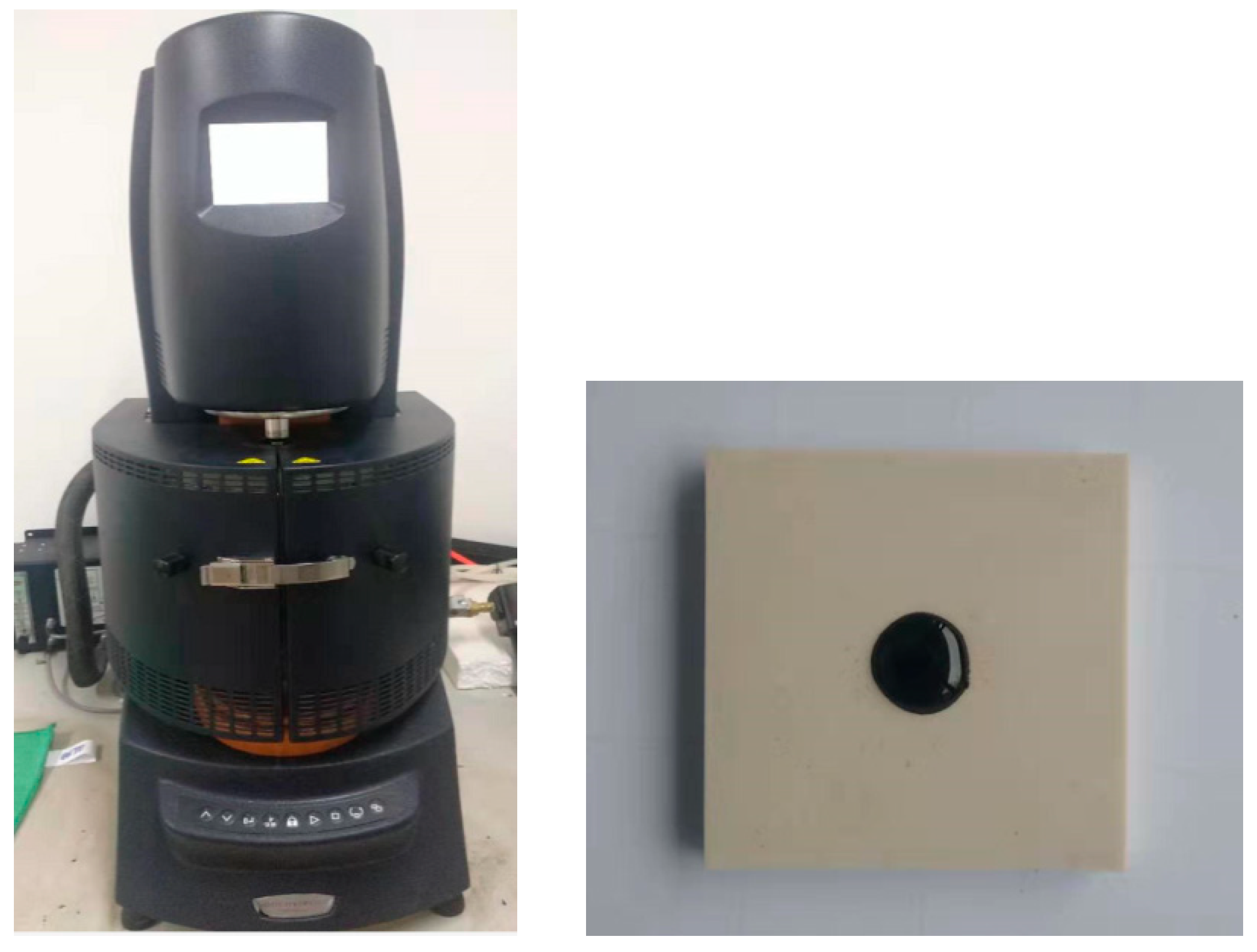
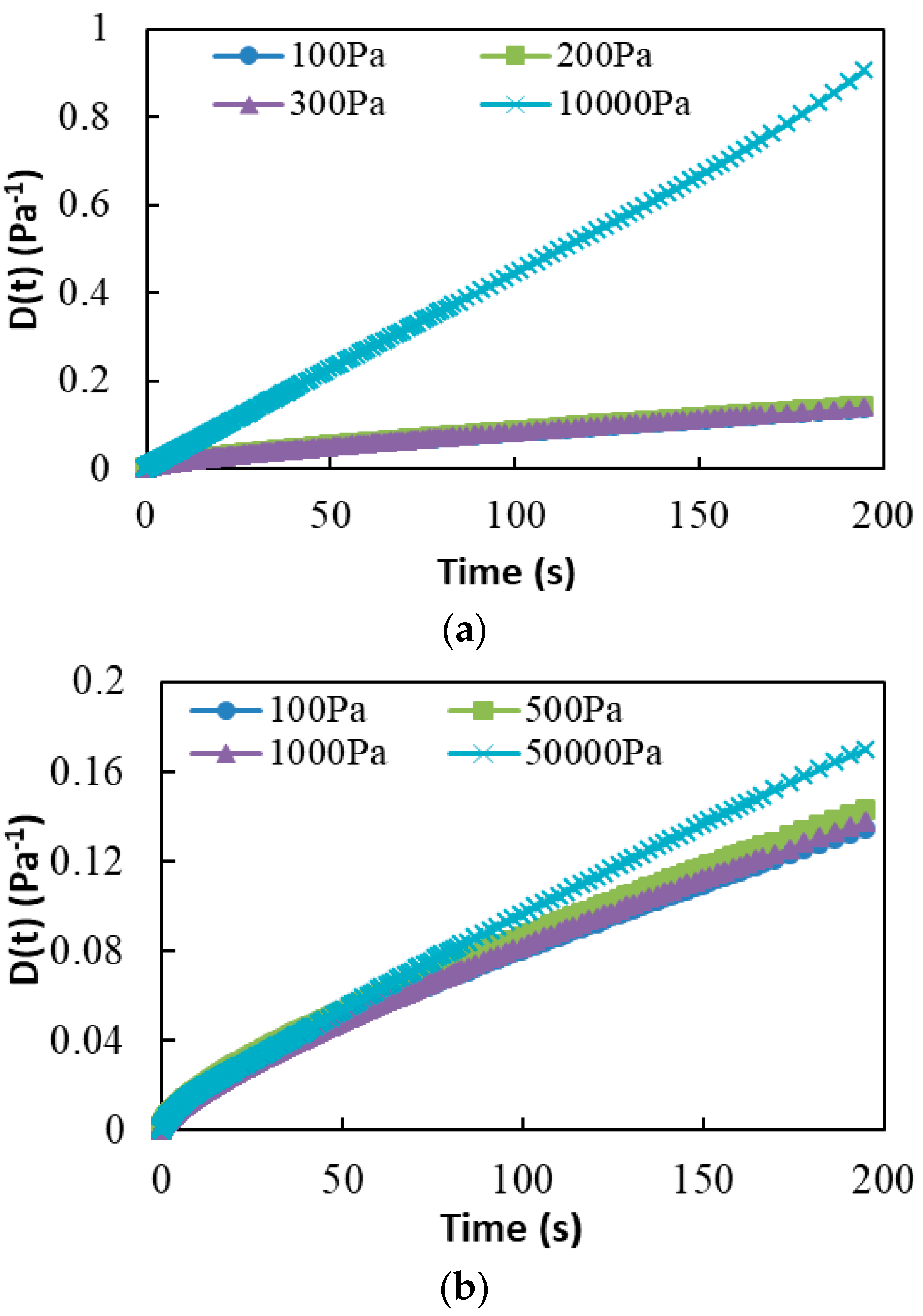
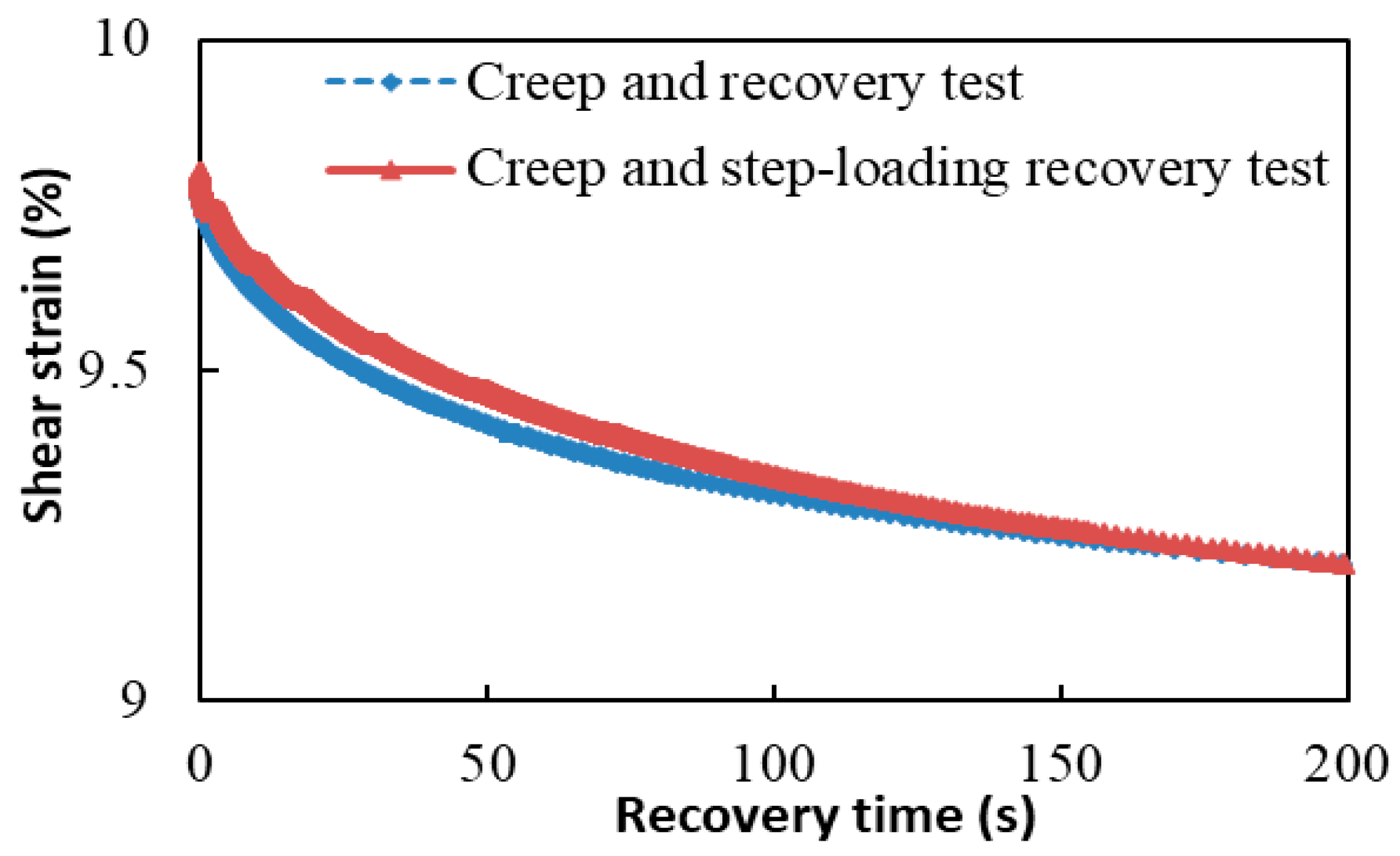

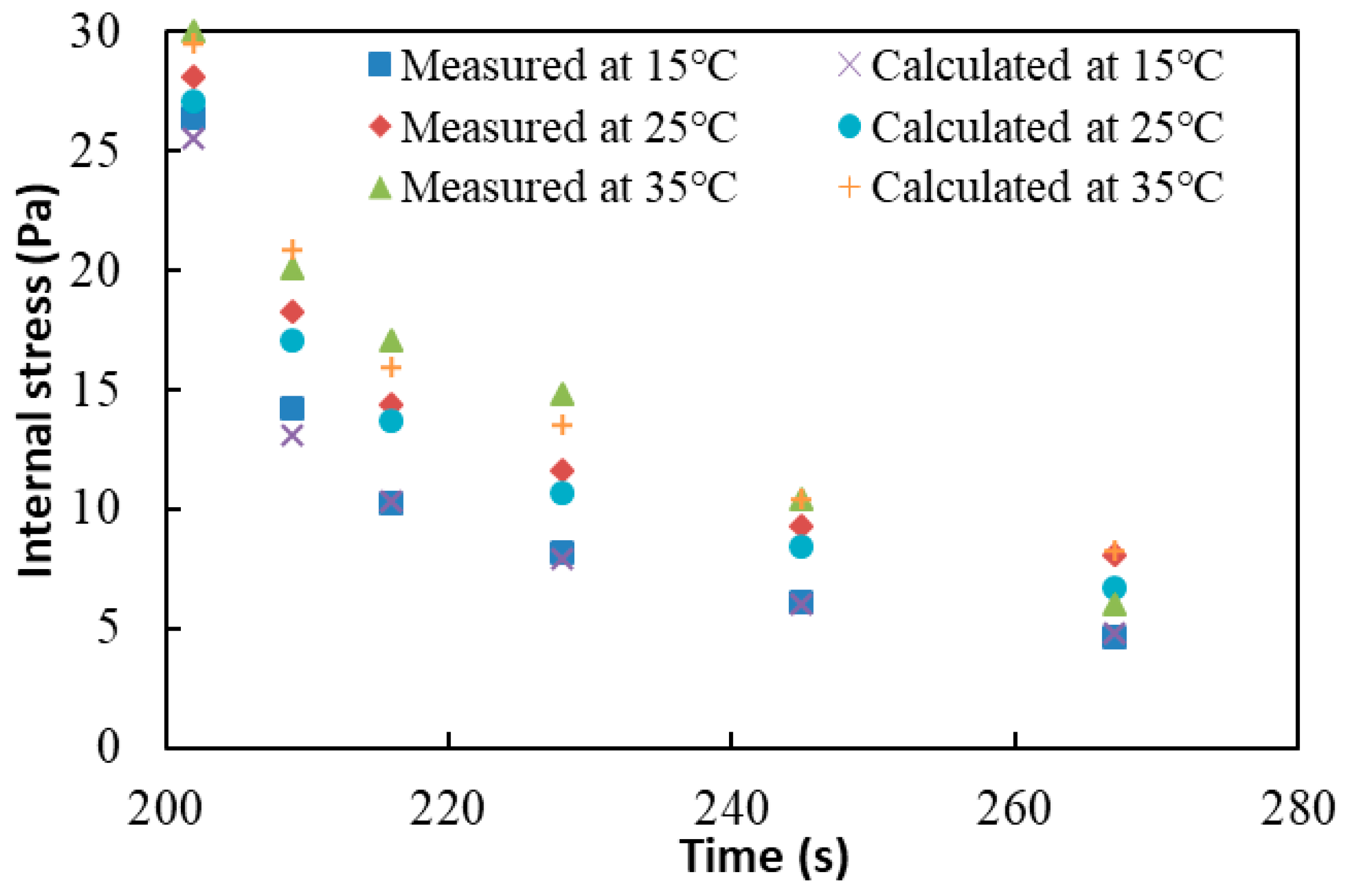



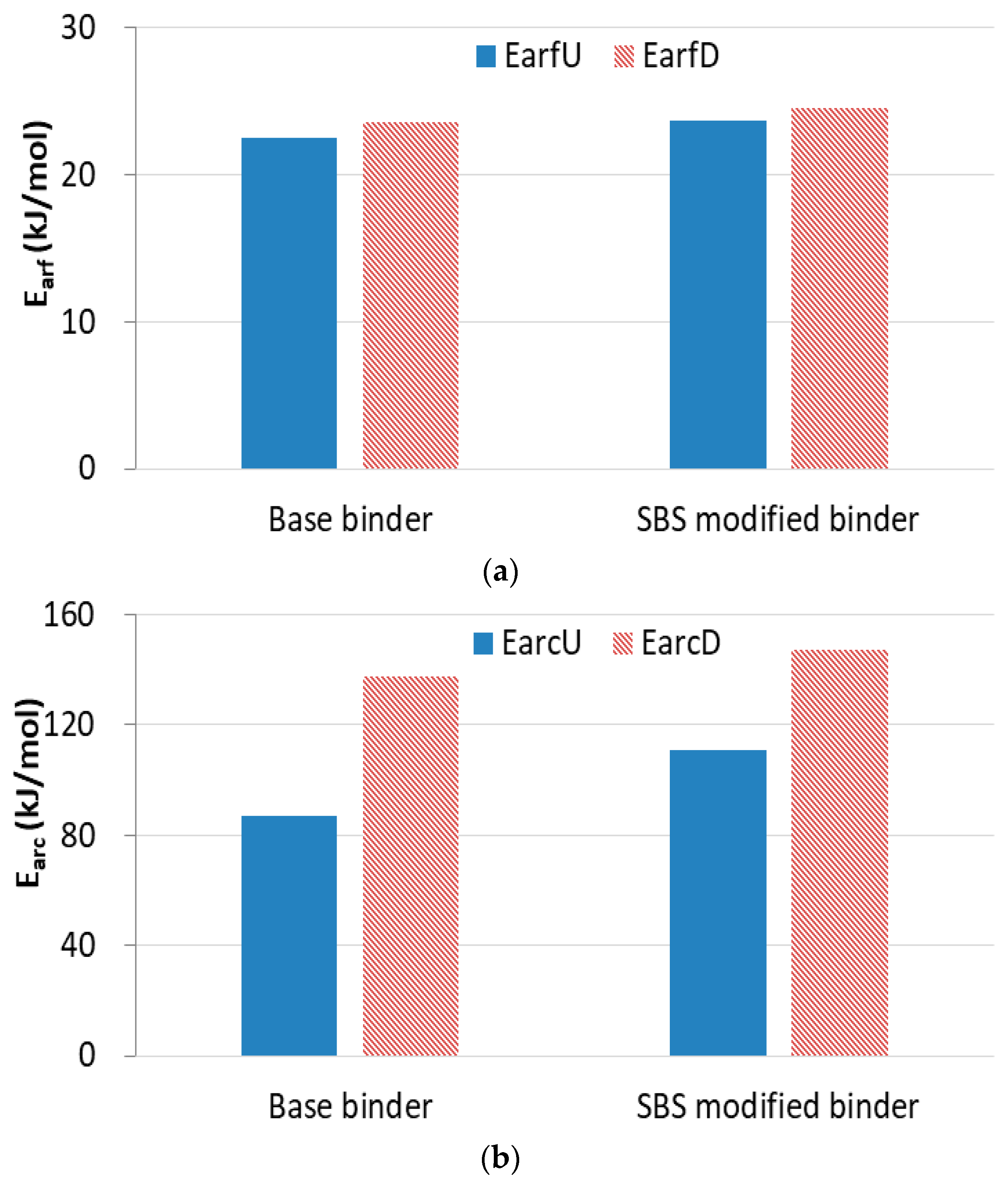
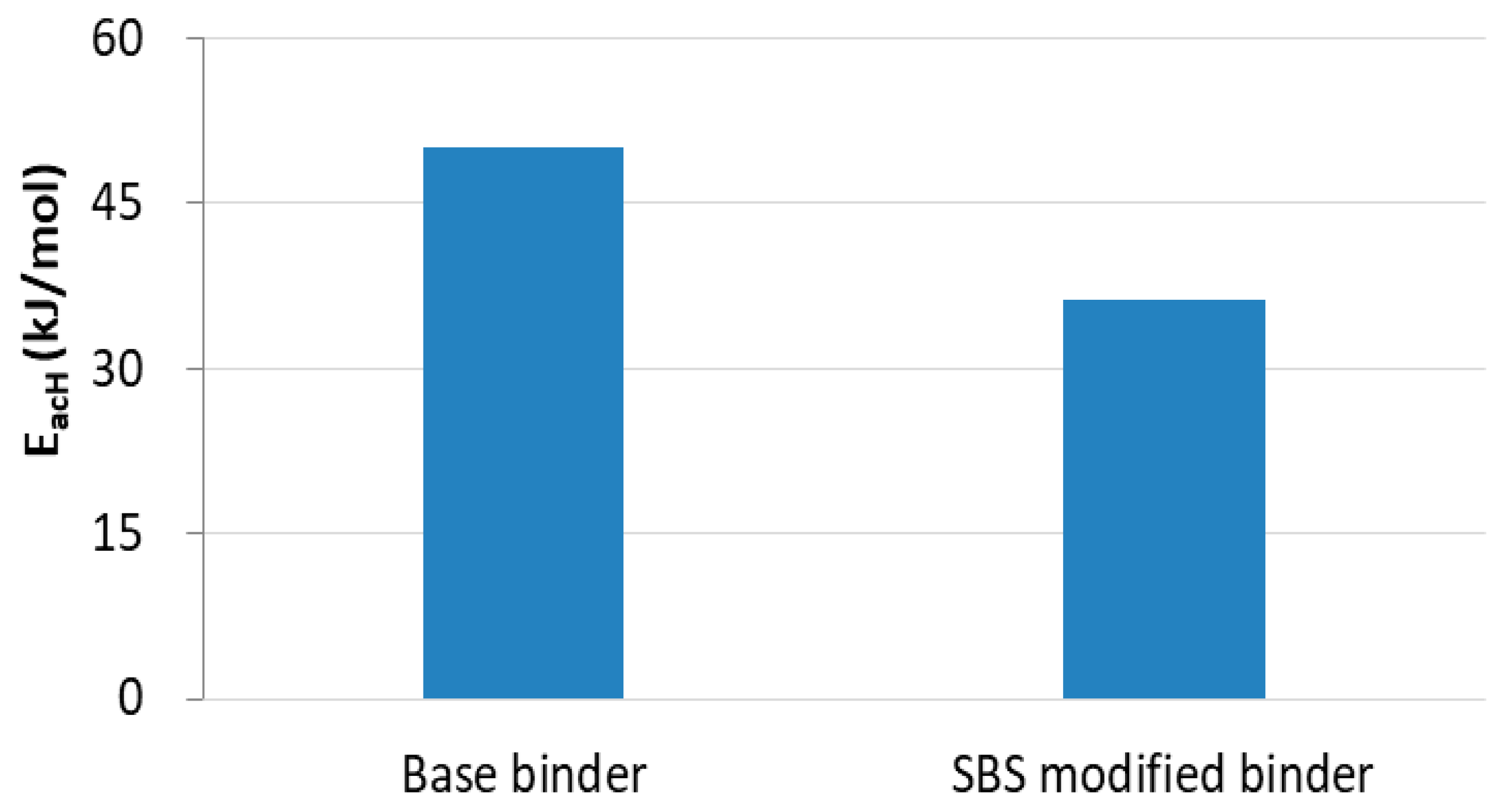
| Step Number | Step-Load Number | ||||||
|---|---|---|---|---|---|---|---|
| 1 | 2 | 3 | 4 | 5 | 6 | 7 | |
| (a) Loading values of the nondestructive test | |||||||
| 1 | 20%PN | 10%PN | 8%PN | 6%PN | 4%PN | 2%PN | \ |
| 2 | 40%PN | 35%PN | 25%PN | 15%PN | 12%PN | 10%PN | \ |
| (b) Loading values of the destructive test | |||||||
| 1 | 10%PD | 8%PD | 6%PD | 5%PD | 4%PD | 2%PD | 1%PD |
| 2 | 30%PD | 20%PD | 15%PD | 10%PD | 8%PD | 6%PD | 4%PD |
| 3 | 50%PD | 40%PD | 30%PD | 25%PD | 20%PD | 15%PD | 10%PD |
| Test Parameters | Requirement | Result | Method |
|---|---|---|---|
| Penetration at 25 °C, 0.1 mm | 60–80 | 74 | GB/T 4509 [22] |
| Softening point, °C | 44–57 | 47.3 | GB/T 4507 [23] |
| Ductility at 5 °C, cm | 100(Min) | 150 | GB/T 4508 [24] |
| Density at 25 °C, g/cm3 | — | 1.028 | GB/T 8928 [25] |
| Test Parameters | Requirement | Result | Method |
|---|---|---|---|
| Penetration at 25 °C, 0.1 mm | 40–60 | 56 | T0604-2011 [26] |
| Softening point, °C | 60 (Min) | 88.4 | T0606-2011 [26] |
| Ductility at 5 °C, cm | 20 (Min) | 36.5 | T0605-2011 [26] |
| Density at 25 °C, g/cm3 | 1.01–1.06 | 1.024 | T0605-2011 [26] |
© 2020 by the authors. Licensee MDPI, Basel, Switzerland. This article is an open access article distributed under the terms and conditions of the Creative Commons Attribution (CC BY) license (http://creativecommons.org/licenses/by/4.0/).
Share and Cite
Ma, F.; Luo, X.; Huang, Z.; Wang, J. Characterization of Recovery in Asphalt Binders. Materials 2020, 13, 920. https://doi.org/10.3390/ma13040920
Ma F, Luo X, Huang Z, Wang J. Characterization of Recovery in Asphalt Binders. Materials. 2020; 13(4):920. https://doi.org/10.3390/ma13040920
Chicago/Turabian StyleMa, Fuquan, Xue Luo, Zhiyi Huang, and Jinchang Wang. 2020. "Characterization of Recovery in Asphalt Binders" Materials 13, no. 4: 920. https://doi.org/10.3390/ma13040920
APA StyleMa, F., Luo, X., Huang, Z., & Wang, J. (2020). Characterization of Recovery in Asphalt Binders. Materials, 13(4), 920. https://doi.org/10.3390/ma13040920





